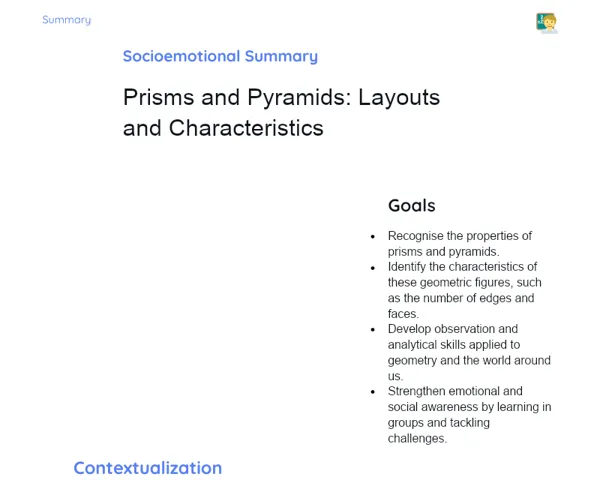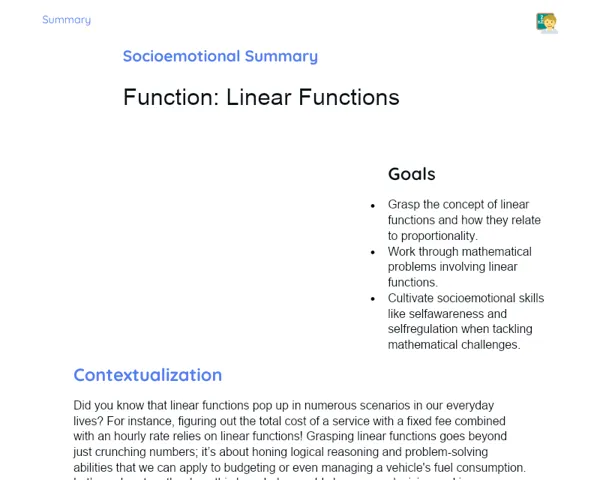Socioemotional Summary Conclusion
Goals
1. Grasp the formula for determining the volume of prisms and how the area of the base relates to the height.
2. Cultivate the ability to recognise and apply the volume formula to various types of prisms.
Contextualization
Have you ever thought about how architects and engineers are able to design those massive buildings we see? Or how product designers manage to create packaging that fits things just right? That’s the fascinating world of spatial geometry at play! By calculating the volume of prisms, we can effectively plan, build, and even design packaging. Let's dive in together and explore how you can use these concepts in your everyday life! 🚀📦
Exercising Your Knowledge
Definition of Prism
A prism is a geometric shape that has two parallel and identical bases, with its lateral faces being parallelograms. Understanding this concept is key because it helps us identify the unique characteristics of prisms, such as their bases and lateral faces. This understanding serves as an important foundation for calculating volumes and other geometric properties.
-
Parallel Bases: The bases of a prism are both congruent and parallel, which means they share the same dimensions and shape.
-
Lateral Faces: The sides of a prism are always parallelograms, regardless of what shape the bases are.
-
Importance of Understanding: Knowing how a prism is structured is vital for correctly calculating its volume and other geometric features.
Base Area
The base of a prism can take the form of any polygon. To determine the area, you must use the suitable formula for the particular polygon involved. The area of the base is central to figuring out the prism’s volume because it indicates how much space the base covers.
-
Variability of Bases: A prism’s base could be triangular, rectangular, hexagonal, etc.
-
Area Formulas: Each type of base has its own way to calculate area, for example, for rectangles it’s A = b * h, whereas for triangles it’s A = (b * h) / 2.
-
Relevance to Volume: To discover the total volume, the area of the base is multiplied by the height of the prism.
Height of the Prism
The height is the straight-line distance between the two bases of the prism. This measurement is crucial for volume calculations, as the height, along with the base area, defines the three-dimensional space the prism occupies.
-
Perpendicular Distance: The height should always be measured straight up between the two bases of the prism.
-
Influence on Volume: To compute the total volume, the area of the base is multiplied by the height.
-
Visualization: Knowing the height assists in imagining the prism not just as flat shapes but as a solid three-dimensional object.
Volume Formula
To find the volume of a prism, we use the formula V = A_base * h, where V signifies volume, A_base stands for the area of the base, and h represents height. This formula is fundamental in determining the internal space of the prism and has practical applications in various areas like architecture and engineering.
-
Essential Formula: V = A_base * h is the primary formula for calculating prism volume.
-
Area Multiplied by Height: The volume results from multiplying the area of the base by the prism's height.
-
Practical Applications: This formula is essential across many fields for precise calculations, including construction and product design.
Key Terms
-
Prism: A geometric solid with two parallel and matching bases.
-
Base Area: The two-dimensional space taken up by the prism's base.
-
Height: The perpendicular distance between the prism's two bases.
-
Volume: The three-dimensional space that the prism occupies, calculated by V = A_base * h.
For Reflection
-
How did you feel while building the prisms during the practical session? Did you encounter any frustration or moments of triumph?
-
What tactics did you employ to navigate your feelings during those tricky calculations?
-
In what ways could you apply your understanding of prism volume in everyday life or in future job scenarios?
Important Conclusions
-
Spatial geometry is a potent tool not only in maths but also in various professional fields like architecture and engineering.
-
Grasping how to compute the volume of prisms is vital for making accurate measurements in real-life scenarios.
-
The formula V = A_base * h is a key tool for defining the three-dimensional space that a prism occupies, leading to significant practical applications.
Impacts on Society
Knowing and applying spatial geometry has a big effect on society. Architects use these formulas to design buildings and urban spaces in an efficient and precise manner. Picture constructing a sports stadium, where each prism contributes to the total space of the entire venue! Moreover, making efficient use of materials and optimising space are crucial for sustainable and cost-effective practices. In everyday life, understanding prism volume can be invaluable in various situations, from managing storage in a warehouse to selecting appropriate packaging for gifts. Mastering prism volume calculation aids in making pragmatic and functional choices, ensuring better resource management.
Dealing with Emotions
To help you handle your feelings while studying spatial geometry, give the RULER technique a go! First, Recognise how you feel when dealing with these calculations. Then, Understand what’s triggering these feelings: is it the complexity of the calculations? Collaborative work? Label your emotions (like frustration, joy, etc.) and Express them suitably, whether in conversation with a friend or jotting down your thoughts in a journal. Finally, Regulate these emotions with strategies such as taking breaks, breathing deeply, or breaking your work into manageable chunks. Remember, keeping your emotions in check makes learning a much lighter and more productive experience!
Study Tips
-
Make use of visual aids, such as sketches and 3D models, to better grasp prisms and their dimensions.
-
Establish study groups with classmates to discuss and tackle volume calculation problems collaboratively, learning from one another’s insights.
-
Regularly practice volume calculations with real-world examples like boxes and packaging to deepen your understanding and practical application.



